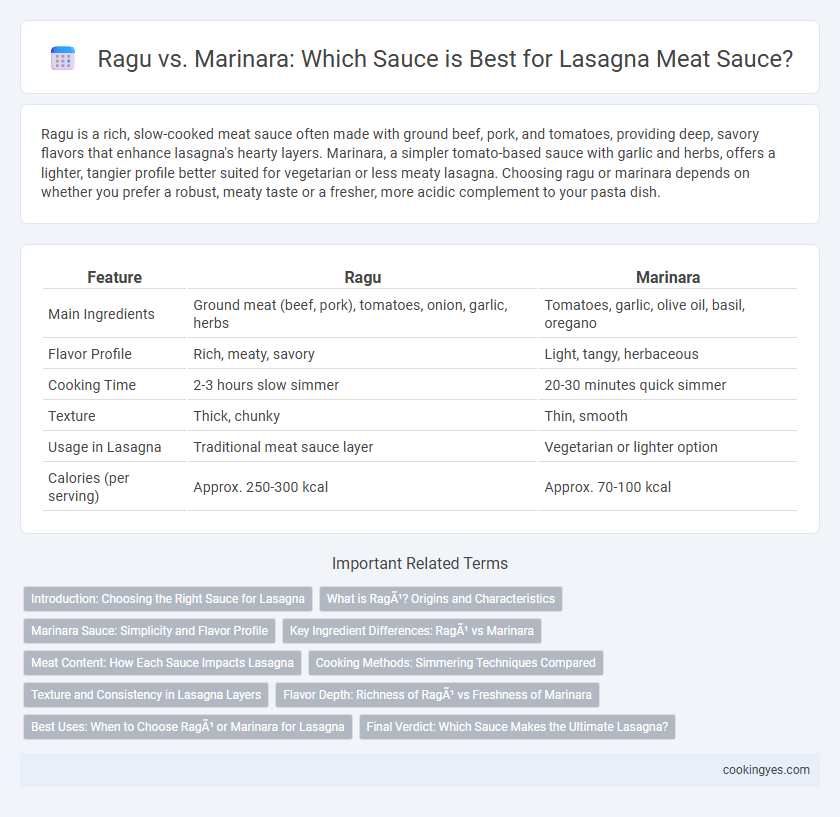Ragu is a rich, slow-cooked meat sauce often made with ground beef, pork, and tomatoes, providing deep, savory flavors that enhance lasagna's hearty layers. Marinara, a simpler tomato-based sauce with garlic and herbs, offers a lighter, tangier profile better suited for vegetarian or less meaty lasagna. Choosing ragu or marinara depends on whether you prefer a robust, meaty taste or a fresher, more acidic complement to your pasta dish.
Table of Comparison
| Feature | Ragu | Marinara |
|---|---|---|
| Main Ingredients | Ground meat (beef, pork), tomatoes, onion, garlic, herbs | Tomatoes, garlic, olive oil, basil, oregano |
| Flavor Profile | Rich, meaty, savory | Light, tangy, herbaceous |
| Cooking Time | 2-3 hours slow simmer | 20-30 minutes quick simmer |
| Texture | Thick, chunky | Thin, smooth |
| Usage in Lasagna | Traditional meat sauce layer | Vegetarian or lighter option |
| Calories (per serving) | Approx. 250-300 kcal | Approx. 70-100 kcal |
Introduction: Choosing the Right Sauce for Lasagna
Ragu and marinara offer distinct flavors and textures essential for authentic lasagna meat sauce. Ragu combines slow-cooked ground meat, tomatoes, and aromatic vegetables, creating a rich, hearty base, while marinara features a simpler, tomato-focused profile with herbs and garlic. Selecting ragu enhances depth and complexity, making it the preferred choice for traditional Italian lasagna.
What is Ragù? Origins and Characteristics
Ragu is a traditional Italian meat sauce originating from Bologna, characterized by its slow-cooked blend of ground beef, pork, tomatoes, onions, carrots, and celery, creating a rich and hearty flavor. Unlike marinara, which is a simple tomato-based sauce, ragu incorporates meat and a longer cooking process to develop depth and complexity. This savory sauce forms the classic base for meat lasagna, offering a robust and savory complement to layers of pasta and cheese.
Marinara Sauce: Simplicity and Flavor Profile
Marinara sauce offers a simple, vibrant flavor profile ideal for lasagna, featuring ripe tomatoes, garlic, and herbs like basil and oregano that enhance rather than overpower the dish. Unlike ragu, which includes meats and slow-cooked depth, marinara provides a lighter, fresher alternative that complements layers of cheese and pasta without heaviness. Its bright acidity balances richness, making it a preferred choice for those seeking a classic yet uncomplicated meat sauce base.
Key Ingredient Differences: Ragù vs Marinara
Ragu for lasagna features a rich combination of ground meat, such as beef or pork, slowly simmered with tomatoes, onions, garlic, and aromatic herbs, creating a hearty and savory sauce. Marinara, in contrast, is a lighter tomato-based sauce primarily made of tomatoes, garlic, olive oil, and fresh basil, offering a fresher and more acidic flavor profile. The key ingredient difference lies in the presence of meat and extended cooking time in ragu versus the simple, vegetable-focused composition of marinara.
Meat Content: How Each Sauce Impacts Lasagna
Ragu features a higher meat content with slow-cooked ground beef, pork, or veal, enriching lasagna with a hearty, savory depth that marinara lacks. Marinara, primarily a tomato-based sauce with herbs and minimal or no meat, results in a lighter, fresher lasagna flavor but less protein and richness. Choosing ragu significantly increases the dish's meatiness and umami intensity, shaping the overall taste and texture of traditional meat lasagna.
Cooking Methods: Simmering Techniques Compared
Ragu for lasagna involves slow simmering of ground meat, vegetables, and tomatoes over low heat to develop deep, rich flavors and tender texture through hours of reduction. Marinara sauce, by contrast, is typically cooked more briefly at medium heat with fresh tomatoes, garlic, and herbs, emphasizing bright, fresh flavors rather than slow-cooked depth. Simmering ragu slowly breaks down collagen in the meat, creating a hearty, thick sauce ideal for lasagna, whereas marinara's quicker simmer preserves acidity and lightness, making it less suited for traditional meat lasagna.
Texture and Consistency in Lasagna Layers
Ragu provides a rich, chunky texture with slow-cooked ground meat and vegetables, creating a thick, hearty consistency that holds well between lasagna layers. Marinara offers a smoother, lighter sauce made primarily from tomatoes and herbs, resulting in a more fluid texture that blends seamlessly but may make the layers less structured. Choosing ragu enhances the lasagna's substantial mouthfeel and distinct layer separation, while marinara delivers a fresh, saucier profile with softer layering.
Flavor Depth: Richness of Ragù vs Freshness of Marinara
Ragu offers a deep, slow-cooked richness with layers of umami from meat, wine, and simmered vegetables, creating a hearty and complex flavor ideal for traditional lasagna. Marinara provides a bright, fresh tomato essence with a lighter, tangy profile that highlights herbs and garlic without the heaviness of meat. Choosing between ragu and marinara significantly impacts lasagna's taste, with ragu delivering robust savoriness and marinara offering vibrant, clean notes.
Best Uses: When to Choose Ragù or Marinara for Lasagna
Ragu, a slow-cooked meat sauce rich with beef, pork, and aromatic vegetables, is ideal for traditional, hearty lasagna recipes that require deep, complex flavors. Marinara, a simpler tomato-based sauce with garlic, herbs, and olive oil, suits lighter or vegetarian lasagna variations, enhancing fresh ingredients without overpowering them. Choose ragu for robust, meaty lasagna and marinara for quick, lighter casseroles that highlight vegetable or cheese layers.
Final Verdict: Which Sauce Makes the Ultimate Lasagna?
Ragu offers a rich, slow-cooked meat sauce with layers of flavor from beef, pork, and aromatic vegetables, creating a hearty and deeply savory base for lasagna. Marinara provides a lighter, tomato-forward sauce with fresh herbs and garlic, ideal for those seeking a tangy, vibrant contrast to the pasta and cheese. For the ultimate lasagna, ragu's complex, meaty profile delivers traditional authenticity and robust taste that elevates the entire dish.
Ragù vs Marinara for Lasagna Meat Sauce Infographic

 cookingyes.com
cookingyes.com